Abstract
The establishment of a network of monitoring sites (term in Russian—«carbon polygons») for monitoring climatic processes as well as the emission and deposition of carbon compounds in various ecosystems is one of the priority tasks in the field of climate and biosphere conservation in the world. This paper presents the results of the study of the soil sections of the «Ladoga» carbon monitoring site. Folic Podzol (Arenic) and Fibric Histosol were considered. These soils are widely represented in the southern taiga subzone and can be used as benchmark monitoring soil sections. As a result of the analysis of chemical parameters, it was revealed that Fibric Histosol and Folic Podzol (Arenic) are characterized by an acidic reaction of pH, pronounced podsolization, and peat accumulation. Fibric Histosol stores a significant amount of soil organic matter (SOM) up to 42.95 kgC/m2. In the analysis of the molecular composition of humic acids (HAs) extracted from the studied soils, it was found that HAs from Fibric Histosol were characterized by a relatively high content of aromatic structural fragments (27–41%), while in Folic Podzol (Arenic), aliphatic structural fragments prevailed (up to 70%). The increase of aromatic structural fragments in the HAs composition indicates the stabilization and conservation of SOM. The creation of a monitoring network will make it possible to identify the main trends of SOM accumulation, determine the conditions under which accumulation occurs, and calculate its contribution to climate change on the planet.
1. Introduction
Soil organic matter (SOM) is a major component of the pedosphere. The Food and Agriculture Organization (FAO) estimates that the largest reservoir of organic carbon is in the humid boreal zone (up to 356 Pg C in 1 m of soil), which, as a result of climate change and landscape degradation, may make an additional contribution to climate change [1]. According to the Kyoto Protocol [2], countries that have ratified the protocol must reduce their carbon dioxide emissions to the level set by the protocol and, as part of the Paris Agreement, contain the temperature rise to 1.5 °C [3]. In the context of the climate crisis, the sequestration of carbon from the atmosphere as well as the assessment of carbon stabilization in soils are among the important tasks of climate preservation [4]. Various programs aimed at assessing the sequestration potential of territories and SOM stocks are initiated in different countries to implement these tasks [5]. Programs of carbon capture and sequestration are actively applied in America, Canada, Europe, and Australia. One of the mechanisms of implementation of these programs is sustainable soil management (SSM) [6]. SSM aims to increase the content of SOM and increase the process of carbon sequestration, thereby contributing to the mitigation of climate change [7,8]. To achieve this, a “low-carbon” development strategy has been initiated in various countries around the world, which involves reducing carbon dioxide and methane emissions through the use of techniques that prevent the rapid mineralization of organic residues in the soil [9,10,11]. This strategy corresponds to the goals of the international initiative “4 per 1000” [12]. The “4 per 1000” initiative consists of the application of carbon-saving technologies. According to the data of A.L. Ivanov and V.S. Stolbovoy, soils in Eurasia could be able to absorb up to 23–28% of the annual carbon dioxide emissions of the territory. This initiative will operate for 12 to 15 years, which corresponds to the saturation of arable soils with carbon [12]. The cold temperate humid zone, which is located in eastern Europe, Canada, and America, is the most active zone in terms of carbon stocks, but according to calculations of experts from FAO UN, it has less potential for sequestration than warmer and wetter zones of the world [4]. It is worth noting that monitoring of natural ecosystems and the creation of databases based on monitoring sites will make it possible to track changes in the balance of carbon and its stocks, as this is a key task under conditions of climate change.
In Russia, to analyze the spatial patterns of SOM stocks and assess the sequestration potential of the territory, the program “Carbon polygons” was established [13], and on 2 September 2022, the most important innovation project of the government “Carbon in ecosystems: monitoring” was established, which will include a network of carbon monitoring sites in the future [14]. Carbon monitoring sites are the place where carbon dioxide emissions and accumulation of SOM are monitored in different types of terrain and land cover. Forest ecosystems of the boreal zone represent a wide range of system-forming ecosystem services, in particular, regulation of the water cycle, atmospheric gas composition, formation of a favorable climate, and soil protection [15]. Under conditions of climate change, the role of such ecosystem services is important as climate regulation increases. Forest cover is capable of sequestering carbon from the atmosphere in significant quantities and storing it in a stable form in the environment [15]. One of the most important areas of work on the carbon monitoring site is the problem of assessing the reservoir and trends of stabilization of organic matter in different natural zones and ecosystems [16,17,18]. By stabilization, we mean the process by which SOM is formed resistant to biotic and abiotic influences [19]. Humic acids (HAs) are determined as a complex of polydispersed materials formed in soils by biochemical reactions during the decay and transformation of plant and microbial remains [20]. Their functional features are determined by the following parameters: climate, precursors of humification, composition, and activity of soil microbiota [21]. The development of climate projects in recent years and the relevance of the issue of stocks, quality, and sequestration of carbon are due to active climate change. Reports at COP 27 suggested that the past eight years were the warmest on record and that the 1.5 °C limit in the Paris Agreement would not be sustainable and temperatures would increase rapidly. Thus, climate change issues are now the most important challenge in terms of science and the preservation of the planet. In this regard, the purpose of this work is to assess the parameters of soil organic matter of the “Ladoga” carbon monitoring site. To achieve this purpose, the following tasks were set: (1) investigate the basic chemical and microbiological properties of soils; (2) calculate the content and stocks of soil organic carbon and nitrogen; (3) study the molecular structure of HAs extracted from soils of the carbon monitoring site.
2. Materials and Methods
2.1. Study Area
The “Ladoga” carbon monitoring site will be located in the Voeykovo settlement, south of the Vsevolozhsk district of the Leningrad region (Figure 1). The formation of the carbon monitoring site will take into account the implementation of the national MRV protocol, where MRV monitoring, reporting, and verification will allow to calculate the amount of sequestration of greenhouse gas emissions. Leningrad region borders the territory of Finland and the European Union, which will further allow comparisons between the sequestration potential of the territory of Russia and Finland. The area is represented by a fluvioglacial eskers relief form; in front of the eskers uplands, the Holocene lowland of Ladoga lake is located, which is merged with the current Ladoga water edge. Such forms of relief combine elevations and depressions on which form various types of soils confined to both drained and over-watered areas [22]. That allows us to study both zonal and introzonal soils characteristic of the Scandinavian Peninsula within one monitoring site. This area belongs to the southern taiga type of zonal plant classification [22]. The parent materials are presented by fluvioglacial sands. The plant cover is represented by Pinus sylvestris, Vaccínium myrtíllus, Vaccínium vítis-idaéa, and Athyrium felix femina in the elevations, and Betula pendula, Calamagrostis arundinacea, Sphagnum platyphyllum, Vaccínium vítis-idaéa in the depressions of the relief. The study area is characterized by a temperate climate, transitional from oceanic to continental, with moderately mild winters and moderately warm summers. The average annual temperature is +5.6 °C, the minimum temperature is −27 °C, and the maximum temperature is +37.7 °C. The average annual relative humidity is 79%. The annual amount of precipitation is 707 mm, and the average number of days with precipitation is 235. The average height of snow cover for 2021–2022 was 41.1 mm [23]. The temperature data were obtained from the meteorological station “Voyeikovo” in the Voyeikovo settlement.
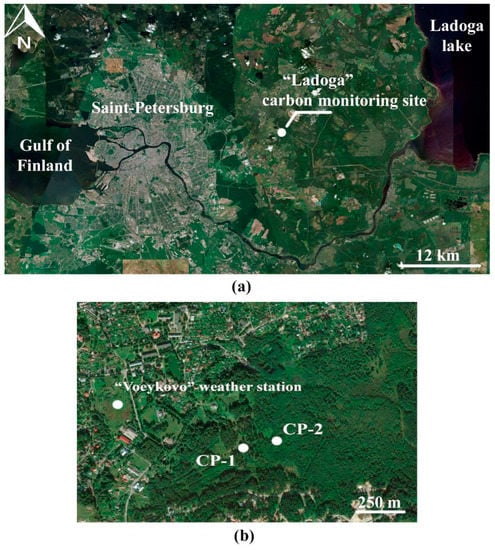
Figure 1.
Location of “Ladoga” carbon monitoring site. Soil ID corresponds to Table 1. (a) North-West of Russia, (b) “Ladoga” carbon monitoring site.
To study the soil cover, two soil transects were made on the top of the hill and in the Holocene lowland of Ladoga lake. Soil description pits are presented in Table 1 and Figure 2.

Table 1.
The description of study soils.
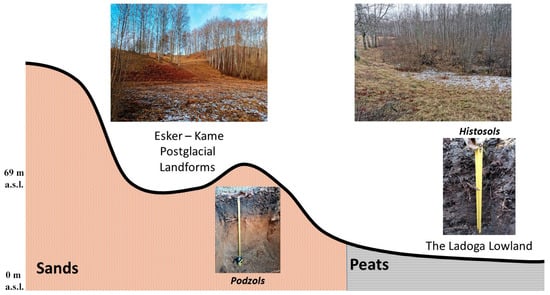
Figure 2.
The studied soil sections of the “Ladoga” carbon monitoring site.
2.2. Methods
2.2.1. Chemical Analysis
The air-dried samples were grounded and passed through a 2 mm sieve in the Laboratory of Applied Ecology department of Saint-Petersburg State University. Soil samples were collected for each horizon to analyze chemical properties. Soils were analyzed according to the following parameters: actual acidity (pHH2O) and potential acidity (pHCaCl2), by a stationary pH meter in an aqueous solution and 1N CaCL2 solution, respectively. The microbiological activity of soils and basal respiration using incubation chambers was determined [26]. The organic carbon and organic nitrogen were analyzed on a CHN analyzer (EA3028-HT EuroVector, Pravia PV, Italy). Carbon stocks (volumetric concentration) within each horizon were determined by the formula:
where, SOC—soil organic carbon (kg/m2); ρ-horizon density; Coc-Organic carbon content (%); 0,1—conversion factor; H—depth, m.
Nitrogen stocks (volumetric concentration) within each horizon were determined by the formula:
where, N—nitrogen stocks (kg/m2); ρ-horizon density; Nc-nitrogen content (%); 0,1—conversion factor; H—depth.
Precision Range: Carbon—±0.01 mg or ±0.5% RSD (Relative standard deviation); Nitrogen—±0.02 mg or ±0.5% RSD.
2.2.2. Elemental Composition of HAs
HAs were isolated from studied soils according to the method recommended by the International Society for the Study of Humic Substances in modification by Vasilevich [27]. The elemental composition of HAs is the percentage content of the elements C, H, N, and O. For the graphical analysis of the elemental composition, we used the van Krevelen diagram [20,28], using H/C-O/C ratios to determine the direction of hydrogenation/dehydrogenation and oxidation/reduction in humic substances. The elemental composition was corrected for weight, moisture, and ash content. The oxygen content was calculated from the difference in mass of whole samples and gravimetric concentrations of C, N, H, and ash. Determination was carried out on an elemental analyzer (EA3028-HT EuroVector, Pravia PV, Italy). The H/C ratio was calculated by the following Formula (1):
The O/C ratio was calculated by the following Formula (2):
2.2.3. Procedure of CP/MAS 13C-NMR Spectroscopy
Solid-state spectra of HAs were determined by CP/MAS 13C-NMR spectroscopy on a Bruker Avance 500 NMR spectrometer in a 3.2 mm ZrO2 rotor. The magic angle rotation rate was 20 kHz, and the nutation frequency for cross-polarization u1/2p 1/4 62.5 kHz. The repetition delay was 3 s. Information on the mass of extractable HAs is presented in Table 2. The extraction yields of HAs were calculated by the following Formula (3):

Table 2.
The basic information about HA extraction.
Eight chemical groups in HA were identified by 13C-NMR spectroscopy. Signals from C, H-substituted aliphatic fragments (0–47 ppm), methoxyl and O-, N-substituted aliphatic fragments (46–60 ppm), aliphatic fragments twice substituted with heteroatoms (incl. carbohydrate) and methine carbon of esters and ethers (60–105 ppm), C, H-substituted aromatic fragments (105–144 ppm), O, N-substituted aromatic fragments (144–164 ppm), carboxyl groups, amides and their derivatives (164–183 ppm), quinone groups (183–190 ppm) and aldehyde and ketone groups (190–204 ppm) were identified. The aromatic fragments were determined by the sum of chemical shifts 108–164 and 183–190 ppm. The aliphatic fragments were determined by the sum of chemical shifts 0–105, 164–183, and 190–204 ppm. The degree of hydrophobicity (AL h,r+AR h,r) was calculated as a sum of 0–47 and 105–144 ppm. The degree of organic matter transformation (C,H-AL/O,N-AL) was determined by the ratio of integrals in the areas of 0–46/46–110 ppm. The calculation of chemical shifts was performed in MestReNova software (Mestrelab Research, Santiago de Compostela, Spain).
3. Results
3.1. Chemical and Microbial Characteristics of Studied Soils
The soils of the “Ladoga” carbon monitoring site are developed in the southern taiga subzone, characterized by a leaching type of water regime, peat formation, migration of mobile iron and aluminum, and humus formation. Profile CP-1 is represented by Folic Podzol (Arenic); the soil is characterized by an acidic reaction of pH from the surface and a gradual transition to a weakly acidic reaction near the parent rocks (Figure 3). In the profile, there are processes of Podzol formation and the formation of whitewash in the horizon A/E, which is associated with the destruction of soil minerals by acidic organic acids and their redistribution in the underlying horizon CP–1 Bs. Morphological features of gleying are absent, which is associated with a relatively high position in the relief. According to the analysis of soil respiration, we note a gradual decrease in microbiological activity from the surface to the parent rock (from 45.4 to 23.8 mg CO2 g−1 day−1, respectively).
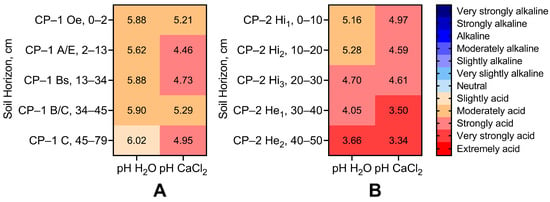
Figure 3.
The pH distribution of studied soils. (A) Folic Podzol (Arenic), (B) Fibric Histosol.
Profile CP-2 is represented by Fibric Histosol; the soil is developed in the depression, in the zone of active hydromorphism of the lowland. This soil has been in overwatering conditions for a long time. The pH reaction of this soil varies from acidic to very acidic. A characteristic feature of this soil is a low degree of transformation of organic remains; with depth, the degree of transformation gradually increases. According to data on soil respiration, the microbiological activity of the soil decreases down the profile (from 223.7 to 101.4 mg CO2 g−1 day−1). The microbiological activity of Fibric Histosol is five times higher than that of Folic Podzol (Arenic) (Figure 4).
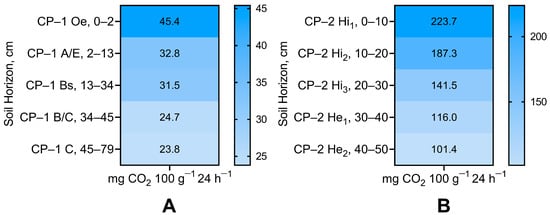
Figure 4.
The soil basal respiration of (A) Folic Podzol (Arenic) and (B) Fibric Histosol.
3.2. Carbon Stocks of «Ladoga» Carbon Monitoring Site
An important ecological function of boreal soils is the sequestration and deposition of SOM. During the process of climate change, the emission of carbon into the atmosphere may be greater than its accumulation in the soil; this may affect the global carbon cycle and accelerate climate change on the planet.
We analyzed the indicators of the humus condition of the soils of the “Ladoga” carbon monitoring site (Figure 5 and Figure 6). The carbon content of Folic Podzol (Arenic) varies from very high (in the CP–1 Oe horizon) to very low (in the CP–1 C horizon), from 7.54 to 0.17%, respectively. There is a sharp decrease in the organic carbon content down the profile. The total carbon stock content is 7.92 kg/m2, and the highest carbon storage is observed in the CP–1 A/E transitional horizon (3.52 kg/m2), where the process of humification is most active. Nitrogen content varies from 0.43% in the CP–1 Oe horizon to 0.03% in the CP–1 C horizon. As well as with the carbon content, there is a sharp decrease in nitrogen down the profile. The total nitrogen stock in Folic Podzol (Arenic) is 0.66 kg/m2; the highest nitrogen stock is observed in the CP–1 A/E transitional horizon and is 0.22 kg/m2. Carbon enrichment of nitrogen in upper soil horizons is very low. This is due to the fact that forest plant litter is poor in ash elements and nitrogen, as well as increased leaching of water-soluble organic acids down the profile.

Figure 5.
Carbon and nitrogen stocks in Folic Podzol (Arenic).
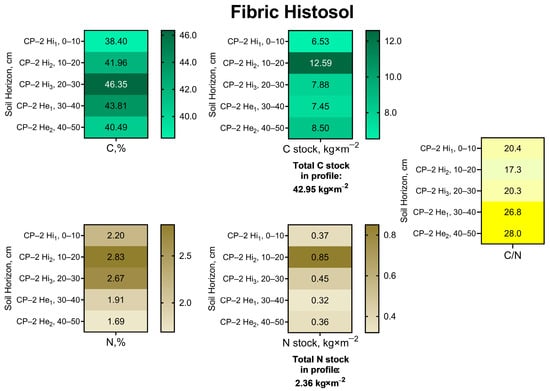
Figure 6.
Carbon and nitrogen stocks in Fibric Histosol.
The studied Fibric Histosol shows a very high carbon content throughout the profile with a maximum at a depth of 20–30 cm. The high carbon content is associated with an increased degree of hydromorphism in the area, peat formation, and peat accumulation. Fibric Histosol is characterized by a very high carbon stock, the total carbon stock being 42.95 kg/m2. The greatest accumulation of carbon occurs at a depth of 10–20 cm. Nitrogen content in the studied soil varies from 0.69 to 2.83%; the maximum content is observed at a depth of 10–20 cm. Nitrogen accumulation in Fibric Histosol is 2.36 kg/m2. The highest accumulation of nitrogen occurs at a depth of 10–20 cm.
Histosols, on par with Chernozems, sequestered the greatest amount of carbon from the atmosphere and are also capable of accumulating and storing it in the form of SOM [29,30]. Therefore, the greatest attention in terms of the contribution of soils to climate change should be given to Histosols because, as a result of the degradation of these soils, a significant amount of carbon can be released into the atmosphere, which provides an additional contribution to climate change on the planet.
3.3. Elemental Composition of HAs
The elemental composition of HAs is the most important indicator determining the progress of oxidation/reduction and hydrogenation/dehydrogenation processes. The HAs we investigated extracted from the soils of the proposed carbon monitoring site accumulated up to 55.41% C in the CP-2 Hi3 in the Histosol horizon (Table 3). The smallest amount corresponded to CP-2 Hi1 in Histosol. The highest nitrogen content was observed in the horizon in the upper CP-1 Oe horizon. The studied soils are characterized by a relatively high C content in the HA composition compared to the Arctic tundra soils, where the C content varies from 36 to 44% [31]. The increased C fraction in peat soils in the middle part of the profile may indicate more homogeneous conditions of humification of plant residues [32]. The H/C ratio is an indicator of the stability of HAs in soils. Based on the obtained data, we can conclude that the process of hydrogenation is most active in sample CP-2 Hi2. It indicates that the process of hydrogen addition to carbon can be caused by the process of humification in extra-humid conditions.

Table 3.
The elemental composition of HAs isolated from soils of the carbon monitoring site (n = 3). Sample ID corresponds to Table 1.
For the graphical analysis of the elemental composition, the van Krevelen diagram is presented. According to this diagram, we can identify the main chemical changes that occur during the transformation of humic acids during soil formation (Figure 7).
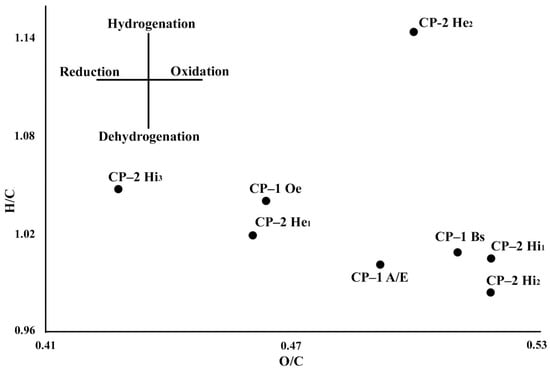
Figure 7.
The van Krevelen diagram of the elemental composition of HAs. Sample ID corresponds to Table 1.
From the obtained diagram, we can conclude that the most hydrogenated HA molecules are formed in the CP-2 He2 horizon, which may indicate a high degree of hydromorphism and low microbiological activity in the underlying soil horizon. The process of dehydrogenation is characteristic of the other studied HAs extracted from the soils of the carbon monitoring site. The process of oxidation of organic residues is most pronounced in the upper soil horizons in Histosol and CP-1 Bs, in which illuviation of haloxides in complex with humus substances occurs.
3.4. 13C NMR Spectroscopy of Studied HAs Isolated from Soils of the Carbon Monitoring Site
We have interpreted the spectra of humic acids obtained according to the 13C NMR spectroscopy method. The obtained spectra are shown in Figure 8. The HAs extracted from Folic Podzol (Arenic) are characterized by the predominance of aliphatic structural fragments, with the greatest contribution from nonpolar alkyls (0–46 ppm). However, aromatic structural fragments (aromatic C=C/C-H) occupy a significant proportion of the HA structure of these soils. Considering the intraprofile distribution, we can note that the share of aliphatic structural fragments (C,H-alkyl) decreases from the soil horizon CP–1 Oe to the middle horizon CP–1 Bs (37–28%, respectively). Aromatic structural fragments in the HA structure increase from 34 to 40%. We noted that in the CP–1 Bs horizon, with the decreases in C,H-alkyl and aromatic C=C/C-H, the content of structural fragments of the O, N-substituted aromatic fragments increases (up to 13%). This may be due to the redistribution of organic acids along the profile and the accumulation of sesquioxides in the CP–1 Bs horizon.
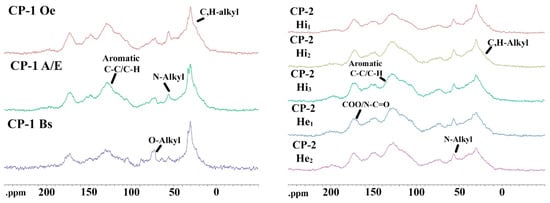
Figure 8.
13C CP/MAS NMR spectroscopy of studied HAs isolated from soils of the “Ladoga” carbon monitoring site.
In the studied spectra of HAs extracted from Fibric Histosol, we distinguish the predominance of C,H—alkyl, aromatic C=C/C-H, and -COOR groups. The HAs extracted from the organogenic soil of the studied carbon monitoring site are quite different from the zonal variant of Folic Podzol (arenic); the predominance of aromatic structural fragments (aromatic C=C/C-H + COOR) in the HA structure is noted (27–41%). When analyzing the formation of HAs along the soil profile, we can note that the formation of aliphatic structural fragments occurs in the upper CP–2 Hi1 and in the middle Hi1 horizons (70–73%, retrospectively). The results obtained by NMR spectroscopy are presented in Table 4.

Table 4.
Percentage of carbon in the main structural fragments of HAs from the studied soils.
Up to 41% of aromatic compounds accumulate in the studied HAs, which could indicate the degree of stabilization of organic matter in Fibric Histosol. However, aliphatic fragments remain dominant in Fibric Histosol. The small fraction of aromatic fragments are primarily related to the quality of humification precursors. As a result of the study, we can note that the maximum content of aliphatic fragments is noted in the upper and middle horizon, which is apparently associated with the processes of peat accumulation and peat formation. Under the conditions of Histosols formation, a significant amount of plant biomass is formed, which is involved in the process of humification and formation of humic acids; the low level of microbiological activity and overwatering conditions have a significant impact on the transformation of organic residues and the formation of aromatic structural fragments in the HA composition. Apparently, under conditions of long-term overwetting, active mineralization of easily mineralizable organic compounds (carbohydrates and lipids) could take place. Mosses can contain up to 80% carbohydrates and lipids and up to 20% aromatic compounds (tannins and flavonoids).
For the analysis of the degree of hydrophobicity and organic matter transformation, the diagram of integrated indicators of the molecular composition of HAs has been presented (Figure 9).
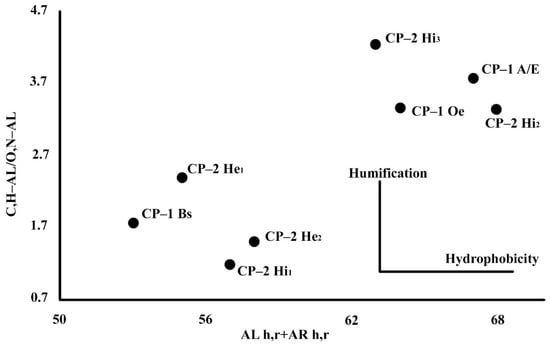
Figure 9.
The diagram of integrated indicators of the molecular composition of HAs. Soil ID corresponds to Table 1.
From the data obtained, it is clear that the most humified organic matter accumulates in the profile Fibric Histosol. The lowest level of humification is revealed in the sample CP–2 Hi1; this is due to the fact that in this horizon, to a lesser degree, occur the processes of transformation of organic matter and the accumulation of organomineral products from the superficial layers. The most hydrophobic molecules in the HAs are formed in the Fibric Histosol profile at a depth of 10 to 30 cm. HAs extracted from the upper soil horizons are characterized by a less number of hydrophobic molecules. The preservation of organic matter under conditions of increased hydromorphism leads to the formation of aromatic substances and SOM conservation. The increase in the fraction of aromatic structural fragments in the composition of HAs is related to the local position in the topography, the duration of the humification process, the hydromorphism of the territory, and the quality of the humification precursors.
4. Discussion
Current climate change affects the carbon balance of wetlands, as well as affecting the exchange of ecosystems with the atmosphere of carbon dioxide and other greenhouse gases [33]. Wetlands are a long-term sink of atmospheric carbon and one of the most important pools among terrestrial ecosystems [34]. Our data indicate that wetland soils accumulate up to 42.95 kg C/m2 at a depth of up to 50 cm. In Arctic tundra soils, up to 25.7 kg C/m2 C is accumulated at a depth of 75 cm and 44.48 kg C/m2 in a frozen state up to 1 m [35]. In southern taiga bogs, up to 64 kg/m2 C are concentrated in the soil layer up to 1 m [29]. Forest ecosystems of the southern taiga are characterized by lower reserves of SOM [36]. Thus, up to 7.92 kg C/m2 is buried in the studied soil, while in the Eastern European part, this indicator, on average, is 14.59 kg C/m2. Following the peat soils, the largest SOM stock is arable soils, in which fertilizers are annually introduced, and the level of biogenic elements necessary for agricultural crops is maintained [29,37]. However, an important challenge to modern soil science is more coverage of territories and the development of monitoring sites in areas with the highest SOM stocks [38]. Due to the complicated logistical situation, most of the Arctic tundra is practically unexplored, although it is here that a substantial amount of organic carbon accumulates and is buried [28,39,40]. Thus, the development of a monitoring system based on a carbon monitoring site will make it possible to create a reliable tool for studying various ecosystems and determining the quality and quantity of SOM for taking further steps to mitigate climate change.
It is generally assumed that an increase in the fraction of aromatic structural fragments leads to the stabilization of SOM since more complex structural fragments are less available for biodegradation and indicate the conservation of HAs [41,42]. According to the data we obtained, HAs are isolated from Fibric. At the same time, soils that are formed under the process of Podzol formation are characterized by the prevalence of aliphatic structural fragments. Typical Podzols of southern taiga were studied by us earlier; HAs extracted from these soils accumulate a significant amount of aliphatic structural fragments (from 69 to 81%), the highest content of aromatic structural fragments was observed in soils over 1500 years BP, and their content decreased in younger soils [36]. In the tundra zones in the Komi Republic, up to 45% of the aromatic structural fragments accumulate in HAs from peat soils, and the content of aromatic structural fragments increased with depth [42]. This may be related to the temperature factor; the more pronounced the processes of freezing/thawing, the more active the splitting of HA molecules to lower molecular weight fragments [42]. According to the supramolecular hypothesis of humic substance formation, HAs are associations of low-molecular-weight compounds, which, depending on environmental factors, can both decompose into low-molecular-weight components and self-organize into consortia [43,44,45,46]. According to the supramolecular hypothesis, we could assume that the formation of HAs in Fibric Histosol and their relatively high content of aromatic structural fragments is related to the self-organization of low-molecular hydrophobic fragments in the humid regime. In general, this agrees with the previously obtained data from the Nizhnesvirsky reserve; the oldest soils and HA have a higher content of aromatic structural fragments, in contrast to the relatively young soils with more active processes of humification and the influence of weak acids on the molecular associations [36]. In recent years, a new view of the formation of OM soils has appeared; according to Wells [46], OM is a meta-chemical hydrogel and expands the idea of the supramolecular structure of OM. According to the notion of meta-chemical hydrogel, it can form, dissipate, and spontaneously recover during turbulent/quiet cycles, indicating the reversible abiotic self-assembly under the influence of the environment and the presence of the necessary structural fragments in its composition [47].
The temperature regime of marshes and wetlands significantly differs from the soils of the zonal series; this is associated with the activity of anaerobic microorganisms and the high level of hydromorphism of the territory. Soils that are located in relative proximity and develop in the same climatic conditions can have significant differences in the qualitative composition of HAs [42,48]. Apparently, it is the temperature regime and the quality of the humification precursors that play a decisive role in the formation of the HA structure in a study region. For the more southern regions, the steppe zone, a significant predominance of aromatic structural fragments is common; thus, up to 68–76% of Car+Caro+COO groups were found in Chernozem [49]. Moving north, the content of aromatic structural fragments in HAs gradually decreases, so in gray forest soils, up to 67% of Car+Caro+COO groups are detected [49]. This is associated with the change of vegetation cover, as well as the types of microbial communities in the soil. The relatively low content of aromatic structural fragments in the Folic Podzol (Arenic) studied by us may be the result of the transformation of coniferous decay rich in lignin-containing substances according to the polymer theory of humification [41,49]. A great role is also played by microbial communities, which specialize in the transformation of different types of litter (coniferous, deciduous, grass), which is the main source of organic matter in the taiga zone [50]. Under conditions of climate change, the process of degradation of organic matter may intensify, during which SOM components will be available for use by microorganisms, leading to additional greenhouse gas emissions into the atmosphere [33]. The formation of databases based on information obtained from carbon monitoring sites is the most effective mechanism for the analysis of carbon stocks in ecosystems recognized around the world. Based on measurements of carbon stocks in different biomes, it was found that the largest carbon stock is in the area of permafrost—2991 tC/ha [51], which is twice the average projected stock value of 1173 tC/ha [4]. This indicates that the reference material may have significant errors and present underestimated data on carbon stocks. When comparing carbon stocks in the northern hemisphere (Canada, Ireland, Scotland, Anglia, USA, Belgium, and Russia), it was found that the natural soils of Russia store much more soil carbon than the countries represented, but the USA leads in carbon stocks in agricultural soils. Intergovernmental organization FAO made calculations on relative sequestration degree for different countries, taking into account three scenarios—the first scenario implies an increase of carbon content in soil by 5%, the second scenario increase of carbon content in soil by 10%, and the third scenario, an increase of carbon content in soil by 20%. Based on FAO projections in conditions of the third scenario, Brazil will be in the 1st place among other countries of the world on the degree of sequestration [4]. The simulation of the sequestration potential is based on mean annual daily temperature, total annual precipitation, total annual evapotranspiration potential, altitude, and soil type [4,8]. Depending on soil type, the predominance of clay materials, and structure, natural soils have an upper limit of carbon accumulation and sequestration. Thus, based on the FAO and IPCC reports, it follows that the highest degree of carbon sequestration is observed in soils saturated with clay minerals because, during carbon accumulation, stable organomineral complexes are formed, which contribute to the conservation of carbon in the soil [1,4]. For long-term monitoring, the carbon monitoring site initiative has been proposed to cover all ecosystems of the country and conduct monitoring of the main atmospheric, soil, and hydrological parameters of the territory. The formation of a monitoring network of the carbon monitoring site will allow a detailed study of the factors influencing the formation of SOM structural fragments in the HAs and identify the main mechanisms of carbon sequestration in various ecosystems.
5. Conclusions
The development of the carbon monitoring network will make it possible to estimate the physicochemical properties of soils, stocks, and the spatial distribution of SOM and, together with molecular research methods, assess the degree of SOM stabilization throughout the country and in the world as a whole. The soils of the “Ladoga” site have significant differences from the studied soils. Folic Podzol (Arenic) is characterized by the process of Podzol formation and relatively low microbiological activity throughout the profile. The carbon content varies from 7.54 to 0.17%, respectively, with a total carbon stock content of 7.92 kg/m2. Fibric Histosol develops during peat formation, peat accumulation, and in conditions of high hydromorphism and a relatively high level of microbiological activity. The carbon content varies from 38.4 to 46.3%, with a total carbon stock of 42.95 kg/m2. The studied soils accumulate a significant amount of SOM, and the study of mechanisms of carbon accumulation in soils on the basis of carbon monitoring sites can help in the development of technologies aimed at carbon sequestration. According to the data obtained by molecular analysis of the composition of HAs extracted from Fibric Histosol soils, it was found that aromatic structural fragments prevail in HAs, which may indicate the stabilization of SOM, accumulation of organic carbon in the soil, and lead to the sequestration of carbon. At the same time, HAs extracted from Folic Podzol (Arenic) are characterized by the predominance of aliphatic structural fragments. The formation of a network of carbon monitoring sites will cover all natural zones of Russia, which will create a unique database on the processes occurring in the atmosphere, hydrosphere, and pedosphere, thus calculating the sequestration potential of the territory and contribute to solving global problems associated with climate change on the planet.
Author Contributions
E.A., T.N. and E.S. conceptualization, E.A. funding, and writing, T.N. and M.M. expedition with fieldwork and soil sampling; V.P. and E.A. wrote the paper, V.P. analysis of HAs. All authors have read and agreed to the published version of the manuscript.
Funding
This work was supported by the project GZ_MDF_2023-1, “From carbon polygon to carbon regulation: potential and ways of development of sequestration carbon industry on the territory of the Leningrad Region and St. Petersburg”.
Data Availability Statement
Center of Chemical Analyses and Materials and Center of Magnetic Resonance Research, Scientific Park of Saint-Petersburg State University. The data of NMR spectroscopy has been obtained from the “Center of Chemical Analyses and Materials and Center of Magnetic Resonance Research”.
Acknowledgments
The article is devoted to the 300th anniversary of the founding of St. Petersburg State University.
Conflicts of Interest
The authors declare no conflict of interest.
References
- Protocol, U.K. The Kyoto Protocol to the United Nations Framework Convention on Climate Change. In Nations Framework Convention on Climate Change; UN: Kyoto, Japan, 1998; p. 26. [Google Scholar]
- United Nations. Paris Agreement; United Nations: Paris, France, 2015; p. 27. [Google Scholar]
- FAO. Global Soil Organic Carbon Sequestration Potential Map—SOCseq v.1.1; FAO: Rome, Italy, 2022; p. 179. [Google Scholar]
- Khosroabadi, F.; Aslani, A.; Bekhrad, K.; Zolfaghari, Z. Analysis of Carbon Dioxide Capturing Technologies and their technology developments. Clean. Eng. Technol. 2021, 5, 100279. [Google Scholar] [CrossRef]
- FAO. Voluntary Guidelines for Sustainable Soil Management; FAO: Rome, Italy, 2017; p. 26. [Google Scholar]
- Hou, D.; Bolan, N.S.; Tsang, D.C.W.; Kirkham, M.B.; O’Connor, D. Sustainable soil use and management: An interdisciplinary and systematic approach. Sci. Total Environ. 2020, 729, 138961. [Google Scholar] [CrossRef] [PubMed]
- Lal, R. Soil carbon sequestration to mitigate climate change. Geoderma 2004, 123, 1–22. [Google Scholar] [CrossRef]
- Babenko, M.; Bobulev, A.; Bokarev, V. Sustainable Development of the UN and Russia; Analytical Center under the Government of the Russian Federation: Moscow, Russia, 2016; p. 44.
- Stolbovoy, V.S.; Savin, I.Y. Can Russian agricultural soils affect climate change? Nat. Russ. 2018, 1, 1. [Google Scholar]
- Tsai, W.-H. Carbon Emission Reduction—Carbon Tax, Carbon Trading, and Carbon Offset. Energies 2020, 13, 6128. [Google Scholar] [CrossRef]
- Ivanov, A.L.; Stolbovoy, V.S. The Initiative “4 per 1000”—A new global challenge for the soils of Russia. Dokuchaev Soil Bull. 2019, 98, 185–202. [Google Scholar] [CrossRef]
- Abakumov, E.V.; Polyakov, V.I.; Chukov, S.N. Approaches and Methods for Studying Soil Organic Matter in the Carbon Polygons of Russia (Review). Eurasian Soil Sci. 2022, 55, 849–860. [Google Scholar] [CrossRef]
- Government of the Russian Federation. Carbon in Ecosystems: Monitoring; Government of the Russian Federation: Moscow, Russia, 2022; p. 24.
- Zamolodchikov, D.G.; Grabovsky, V.I.; Kaganov, V.V. Ecosystem services and spatial distribution of protective forests in the Russian Federation. Russ. J. For. Sci. 2021, 6, 581–592. [Google Scholar]
- Becker, T.; Kutzbach, L.; Forbrich, I.; Schneider, J.; Jager, D.; Thees, B.; Wilmking, M. Do we miss the hot spots?—The use of very high resolution aerial photographs to quantify carbon fluxes in peatlands. Biogeosciences 2008, 5, 1387–1393. [Google Scholar] [CrossRef]
- Bullock, P. Soils in the Urban Environment; Gregory, P.J., Ed.; Wiley-Blackwell: Hoboken, NJ, USA, 1991; p. 184. [Google Scholar]
- Davidson, E.A.; Janssens, I.A. Temperature sensitivity of soil carbon decomposition and feedbacks to climate change. Nature 2006, 440, 165–173. [Google Scholar] [CrossRef]
- Ejarque, E.; Abakumov, E. Stability and biodegradability of organic matter from Arctic soils of Western Siberia: Insights from 13C-NMR spectroscopy and elemental analysis. Solid Earth 2016, 7, 153–165. [Google Scholar] [CrossRef]
- Orlov, D.S. Soil Humic Acids and General Theory Humification; Moscov State University: Moscow, Russia, 1990; p. 325. [Google Scholar]
- Lodygin, E.D.; Beznosikov, V.A.; Vasilevich, R.S. Molecular Composition of Humic Substances in Tundra Soils (C-13-NMR Spectroscopic Study). Eurasian Soil Sci. 2014, 47, 400–406. [Google Scholar] [CrossRef]
- Zavarzina, A.G.; Kravchenko, E.G.; Konstantinov, A.I.; Perminova, I.V.; Chukov, S.N.; Demin, V.V. Comparison of the Properties of Humic Acids Extracted from Soils by Alkali in the Presence and Absence of Oxygen. Eurasian Soil Sci. 2019, 52, 880–891. [Google Scholar] [CrossRef]
- Nitsenko, A.A. Spruce forests of the Leningrad Region. Bull. Leningr. State Univ. Ser. Biol. 1960, 2, 5–16. [Google Scholar]
- RP5. Weather Archive. Available online: https://rp5.ru/%D0%90%D1%80%D1%85%D0%B8%D0%B2_%D0%BF%D0%BE%D0%B3%D0%BE%D0%B4%D1%8B_%D0%B2_%D0%92%D0%BE%D0%B5%D0%B9%D0%BA%D0%BE%D0%B2%D0%BE (accessed on 1 October 2022).
- Jahn, R.; Blume, H.P.; Spaargaren, O.; Schad, P. Guidelines for Soil Description; Food and Agriculture Organization of the United Nations: Rome, Italy, 2006. [Google Scholar]
- Food and Agriculture Organization World Referense Base. IUSS Working Group WRB World Reference Base for Soil Resources 2014; Food and Agriculture Organization World Referense Base: Rome, Italy, 2015; p. 195. [Google Scholar]
- Lal, R.; Kimble, J.M.; Follett, R.F.; Stewart, B.A. Assessment Methods for Soil Carbon; CRC Press: Boca Raton, FL, USA, 2000. [Google Scholar]
- Vasilevich, R.S.; Beznosikov, V.A.; Lodygin, E.D. Molecular Structure of Humus Substances in Permafrost Peat Mounds in Forest-Tundra. Eurasian Soil Sci. 2019, 52, 283–295. [Google Scholar] [CrossRef]
- Sleighter, R.L.; Hatcher, P.G. The application of electrospray ionization coupled to ultrahigh resolution mass spectrometry for the molecular characterization of natural organic matter. J. Mass Spectrom. 2007, 42, 559–574. [Google Scholar] [CrossRef] [PubMed]
- Schepaschenko, D.G.; Mukhortova, L.V.; Shvidenko, A.Z.; Vedrova, E.F. The pool of organic carbon in the soils of Russia. Eurasian Soil Sci. 2013, 46, 107–116. [Google Scholar] [CrossRef]
- Sarzhanov, D.A.; Vasenev, V.I.; Sotnikova, Y.L.; Tembo, A.; Vasenev, I.I.; Valentini, R. Short-term dynamics and spatial heterogeneity of CO2 emission from the soils of natural and urban ecosystems in the Central Chernozemic Region. Eurasian Soil Sci. 2015, 48, 416–424. [Google Scholar] [CrossRef]
- Polyakov, V.; Abakumov, E. Stabilization of organic material from soils and soil-like bodies in the Lena River Delta (13C-NMR spectroscopy analysis). Span. J. Soil Sci. 2020, 10, 170–190. [Google Scholar] [CrossRef]
- Abakumov, E.V. Accumulation and transformation of organic matter in different-aged dumps from sand quarries. Eurasian Soil Sci. 2008, 41, 844–851. [Google Scholar] [CrossRef]
- Knoblauch, C.; Beer, C.; Liebner, S.; Grigoriev, M.N.; Pfeiffer, E.-M. Methane production as key to the greenhouse gas budget of thawing permafrost. Nat. Clim. Change 2018, 8, 309–312. [Google Scholar] [CrossRef]
- Yu, Z.C. Northern peatland carbon stocks and dynamics: A review. Biogeosciences 2012, 9, 4071–4085. [Google Scholar] [CrossRef]
- Zubrzycki, S.; Kutzbach, L.; Grosse, G.; Desyatkin, A.; Pfeiffer, E.M. Organic carbon and total nitrogen stocks in soils of the Lena River Delta. Biogeosciences 2013, 10, 3507–3524. [Google Scholar] [CrossRef]
- Abakumov, E.; Polyakov, V.; Orlova, K. Podzol development on different aged coastal bars of Lake Ladoga. Tomsk State Univ. J. Biol. 2019, 48, 6–31. [Google Scholar] [CrossRef]
- LiLiu, X.; Wang, S.; Zhuang, Q.; Jin, X.; Bian, Z.; Zhou, M.; Meng, Z.; Han, C.; Guo, X.; Jin, W.; et al. A Review on Carbon Source Sink in Arable Land, Ecosystems. Land 2022, 11, 580. [Google Scholar] [CrossRef]
- Ivanov, A.L.; Savin, I.Y.; Stolbovoy, V.S.; Dukhanin, Y.A.; Kozlov, D.N. Methodological approaches to the formation of a unified national system of monitoring and accounting of carbon balance and greenhouse gas emissions on lands of the agricultural fund of the Russian Federation. Dokuchaev Soil Bull. 2021, 108, 175–218. [Google Scholar] [CrossRef]
- Schuur, E.A.G.; McGuire, A.D.; Schädel, C.; Grosse, G.; Harden, J.W.; Hayes, D.J.; Hugelius, G.; Koven, C.D.; Kuhry, P.; Lawrence, D.M.; et al. Climate change and the permafrost carbon feedback. Nature 2015, 520, 171–179. [Google Scholar] [CrossRef]
- Zubrzycki, S.; Kutzbach, L.; Pfeiffer, E.M. Permafrost-affected soils and their carbon pools with a focus on the Russian Arctic. Solid Earth 2014, 5, 595–609. [Google Scholar] [CrossRef]
- Semenov, V.M.; Ivannikov, L.A.; Tulina, A.S. Stabilization of organic matter in the soil. Agrochimia 2009, 10, 77–96. [Google Scholar]
- Vasilevich, R.; Lodygin, E.; Beznosikov, V.; Abakumov, E. Molecular composition of raw peat and humic substances from permafrost peat soils of European Northeast Russia as climate change markers. Sci. Total Environ. 2018, 615, 1229–1238. [Google Scholar] [CrossRef]
- Piccolo, A.; Conte, P.; Trivellone, E.; van Lagen, B.; Buurman, P. Reduced Heterogeneity of a Lignite Humic Acid by Preparative HPSEC Following Interaction with an Organic Acid. Characterization of Size-Separates by Pyr-GC-MS And 1H-NMR Spectroscopy. Environ. Sci. Technol. 2002, 36, 76–84. [Google Scholar] [CrossRef] [PubMed]
- Šmejkalová, D.; Piccolo, A. Aggregation and Disaggregation of Humic Supramolecular Assemblies by NMR Diffusion Ordered Spectroscopy (DOSY-NMR). Environ. Sci. Technol. 2008, 42, 699–706. [Google Scholar] [CrossRef] [PubMed]
- Zavarzina, A.G.; Danchenko, N.N.; Demin, V.V.; Artemyeva, Z.S.; Kogut, B.M. Humic Substances: Hypotheses and Reality (a Review). Eurasian Soil Sci. 2021, 54, 1826–1854. [Google Scholar] [CrossRef]
- Wells, M.J.M. Supramolecular Answers to the Organic Matter Controversy. J. Environ. Qual. 2019, 48, 1644–1651. [Google Scholar] [CrossRef]
- Wells, M.J.M.; Stretz, H.A. Supramolecular architectures of natural organic matter. Sci. Total Environ. 2019, 671, 1125–1133. [Google Scholar] [CrossRef]
- Byun, E.; Rezanezhad, F.; Fairbairn, L.; Slowinski, S.; Basiliko, N.; Price, J.S.; Quinton, W.L.; Roy-Léveillée, P.; Webster, K.; Van Cappellen, P. Temperature, moisture and freeze–thaw controls on CO2 production in soil incubations from northern peatlands. Sci. Rep. 2021, 11, 23219. [Google Scholar] [CrossRef]
- Kholodov, V.; Konstantinov, A.; Kudriavsev, A.; Perminova, I. Structure of humic acids of zonal soils by 13C NMR spectroscopy. Eurasian Soil Sci. 2011, 9, 1064–1073. [Google Scholar]
- Vuong, T.-M.-D.; Zeng, J.-Y.; Man, X.-L. Soil fungal and bacterial communities in southern boreal forests of the Greater Khingan Mountains and their relationship with soil properties. Sci. Rep. 2020, 10, 22025. [Google Scholar] [CrossRef]
- Watson, R.T.; Noble, I.R.; Bolin, B.; Ravindranath, N.H.; Verardo, D.J.; Dokken, D.J. Land Use, Land-Use Change and Forestry; Intergovernmental Panel for Climate Change: Geneva, Switzerland, 2000; p. 375. [Google Scholar]
Disclaimer/Publisher’s Note: The statements, opinions and data contained in all publications are solely those of the individual author(s) and contributor(s) and not of MDPI and/or the editor(s). MDPI and/or the editor(s) disclaim responsibility for any injury to people or property resulting from any ideas, methods, instructions or products referred to in the content. |
© 2023 by the authors. Licensee MDPI, Basel, Switzerland. This article is an open access article distributed under the terms and conditions of the Creative Commons Attribution (CC BY) license (https://creativecommons.org/licenses/by/4.0/).